Updated ErP and Energy Label Directives for LED in 2021
Table of Contents
To enhance energy efficiency and diminish CO2 emissions, the EU Commission has introduced fresh ErP and energy label guidelines for LED products.
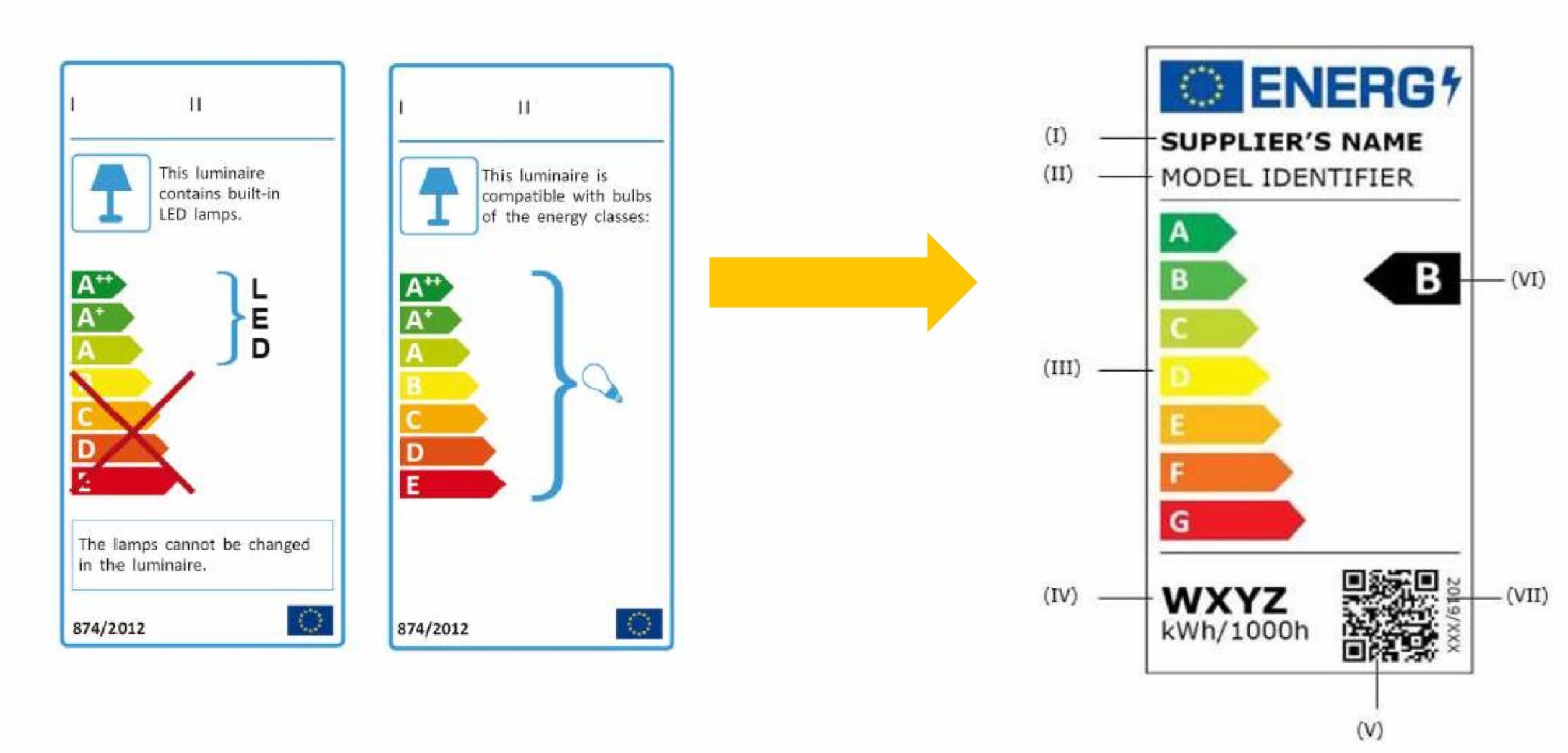
What is Erp?
ErP stands for Energy-related Products and refers to the Energy-related Products Directive (ErP) 2009/125/EC, which replaced the previous Energy-using Products Directive (EuP) in November 2009. The EuP was initially implemented in 2005 to meet the requirements of the Kyoto Agreement, aimed at reducing carbon dioxide emissions.
The ErP directive expanded the scope of products covered compared to EuP. While EuP only included directly energy-consuming or using products, ErP now encompasses energy-related products. This includes items such as water-saving taps, among others.
The objective is to encompass the entire product supply chain, including the design stage, production, transport, packaging, storage, and more.
The previous ErP directives, EC 244/2009, EC 245/2009, EU 1194/2012, and the Energy Label directive EU 874/2012, were in effect for over ten years. Recently, the European Commission reviewed these regulations, analyzing the technical, environmental, and economic aspects of lighting products and real-life user behavior. As a result, new ErP directives EU 2019/2020 and energy label EU 2019/2015 were issued.
Timeline for New ErP & Energy Label Directives
New ErP Directive (EU) 2019/2020:
- Regulation effective date: December 25, 2019
- Implementation of the Regulation: September 1, 2021
- Previous regulations and their expiration dates: (EC) 244/2009, (EC) 245/2009 & (EU) 1194/2012 will no longer be valid starting from September 1, 2021.
EU Regulation 2019/2015 for New Energy Efficiency Labeling
- Effective Date: December 25, 2019
- Regulation Implementation Date: September 1, 2021
- Expiration of Old Regulations: The previous Regulation (EU) No 874/2012 will become invalid starting September 1, 2021, while the energy efficiency label for lamps became invalid on December 25, 2019.
Scope of the New ErP Directive
This Regulation sets forth eco-design requirements for the market introduction of:
(a) light sources
(b) separate control gears.
These requirements also apply to light sources and separate control gears sold as part of a containing product.
Definition of Light Sources
A “light source” refers to an electrically operated product designed to emit light or, in the case of non-incandescent light sources, capable of being adjusted to emit light. The light source must possess the following optical characteristics:
(a) The chromaticity coordinates x and y fall within the range: (Note: Only white light is within this range; colors such as red, green, blue, yellow, and pink are not included.) 0.270 < x < 0.530, and -2.3172x^2 + 2.3653x – 0.2199 < y < -2.3172x^2 + 2.3653x – 0.1595;
(b) The luminous flux should be less than 500 lumens per mm2 of the projected light-emitting surface area, as defined in Annex I;
(c) The luminous flux should range between 60 and 82,000 lumens;
(d) The color rendering index (CRI) should be greater than 0.
The lighting technology utilized can be incandescence, fluorescence, high-intensity discharge, inorganic light-emitting diodes (LEDs), organic light-emitting diodes (OLEDs), or a combination thereof. The light source must be verifiable as a light source according to the procedure outlined in Annex IV.
High-pressure sodium (HPS) light sources that do not meet condition (a) are still considered light sources for this Regulation.
Exclusions from the definition of light sources include:
(a) LED dies or LED chips;
(b) LED packages;
(c) Products containing light source(s) from which these light source(s) can be removed for verification;
(d) Light-emitting parts contained within a light source that cannot be removed for verification as a light source.
Definition of Control Gear
The term “control gear” refers to one or more devices that can be physically integrated into a light source or exist separately. These devices are designed to adapt the mains electricity to the specific electrical requirements of one or more light sources while complying with safety regulations and electromagnetic compatibility. Control gear may perform various functions such as transforming the power supply and starting voltage, limiting current during operation and preheating, preventing cold starting, correcting power factor, and reducing radio interference.
It is important to note that control gear excludes power supplies regulated under Commission Regulation (EC) No 278/2009. Additionally, it does not include lighting control parts or non-lighting components, as defined in Annex I, even if they are physically integrated with control gear or marketed together as a single product.
A Power over Ethernet (PoE) switch does not fall under the definition of control gear as stated in this Regulation. A “Power-over-Ethernet switch” or “PoE switch” refers to equipment that facilitates poppy and data handling between the mains and office equipment and light sources for data transfer and power provision.
Definition of Separate Control Gear
“Separate control gear” refers to control integrated with a light source. It is either a standalone or part of a containing product.
Definition of Containing Product
A “containing product” is a product that includes one or more light sources and separate control gear. Examples of containing products include luminaires that can be disassembled to verify the light source(s); they independently have household appliances incorporating light source(s), and furniture items such as shelves, mirrors, or display cabinets containing a light source(s). If a containing product cannot be disassembled to verify the light source(s) and separate control gear, the entire product is considered a light source.
Requirements of the New ErP Directive Energy efficiency standards
(a) Starting from September 1, 2021, the power consumption declared for a light source, denoted as Pon, must not exceed the maximum permitted power, Ponmax (measured in W). Ponmax is determined based on the declared useful luminous flux, Φuse (measured in lm), and the declared color rendering index, CRI (-), using the following formula: Ponmax = C × (L + Φuse/(F × η)) × R;
The values for the threshold efficacy (η in lm/W) and the end loss factor (L in W) are provided in Table 1, varying depending on the type of light source. These values are constants used for calculations and do not reflect the actual parameters of the light sources. The threshold efficacy does not represent the minimum required efficacy; the latter can be determined by dividing the useful luminous flux by the computed maximum allowed power.
The fundamental values for the correction factor (C) are specified in Table 2, which vary based on the type of light source, along with additional elements that may be added to C for particular light source features.
The efficacy factor (F) is 1.00 for non-directional light sources (NDLS) that use total flux.
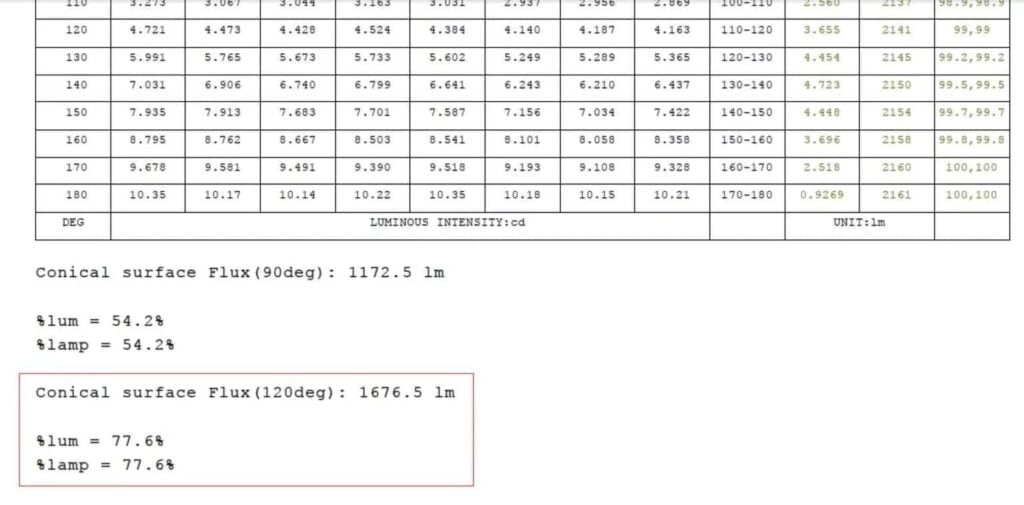
The luminous efficacy for directional light sources (DLS), measured using flux within a cone, is 0.85.
The Color Rendering Index (CRI) factor (R) is determined as follows:
- For CRI values ≤ 25, the CRI factor is 0.65.
- For CRI values greater than 25, the CRI factor is calculated as (CRI + 80) divided by 160, rounded to two decimal places.

Table 2

- Cumulative bonuses on correction factor C shall be applied where applicable.
- The High Lumen Maintenance (HLLS) bonus should not be combined with the basic C-value for Dimming Light Sources (DLS). Instead, the basic C-value for Non-Dimming Light Sources (NDLS) should be used for HLLS.
- Light sources that allow users to adjust the spectrum, beam angle, useful luminous flux, color rendering index (CRI), correlated color temperature (CCT), or change the directional/non-directional status of the light source, must be evaluated using the reference control settings.
- A light source’s standby power (PSB) must not exceed 0.5 W.
- A connected light source’s networked standby power (Pnet) must not exceed 0.5 W.
- The values for Psb and Pnet should not be added together.
- Starting September 1, 2021, the minimum energy efficiency requirements for a separate control gear operating at full load shall apply as specified in Table 3.
Table3
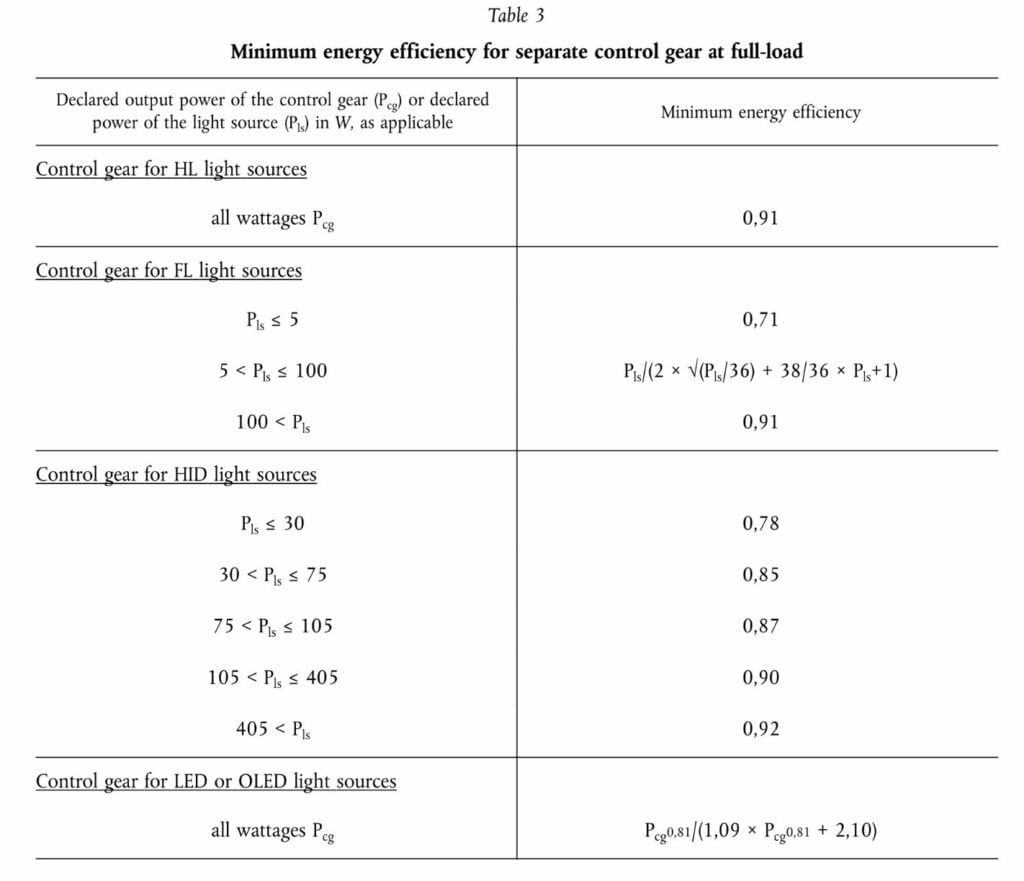
The multi-wattage separate control gears must meet the requirements stated in Table 3 based on their maximum declared operating power.
For separate control gears designed to operate without a load, the no-load power (Pno) should not exceed 0.5 W. This requirement applies only to those different control gears for which the manufacturer or importer has specified in the technical documentation that they are intended for no-load mode.
A separate control gear’s standby power (PSB) should not exceed 0.5 W.
The networked standby power (Pnet) should not exceed 0.5 W when a separate control gear is connected to a network. The values for Psb and Pnet should not be combined; they should be evaluated separately.
Requirements for Functionality
Effective September 1, 2021, the functional requirements outlined in Table 4 will be enforced for light sources:
Table 4
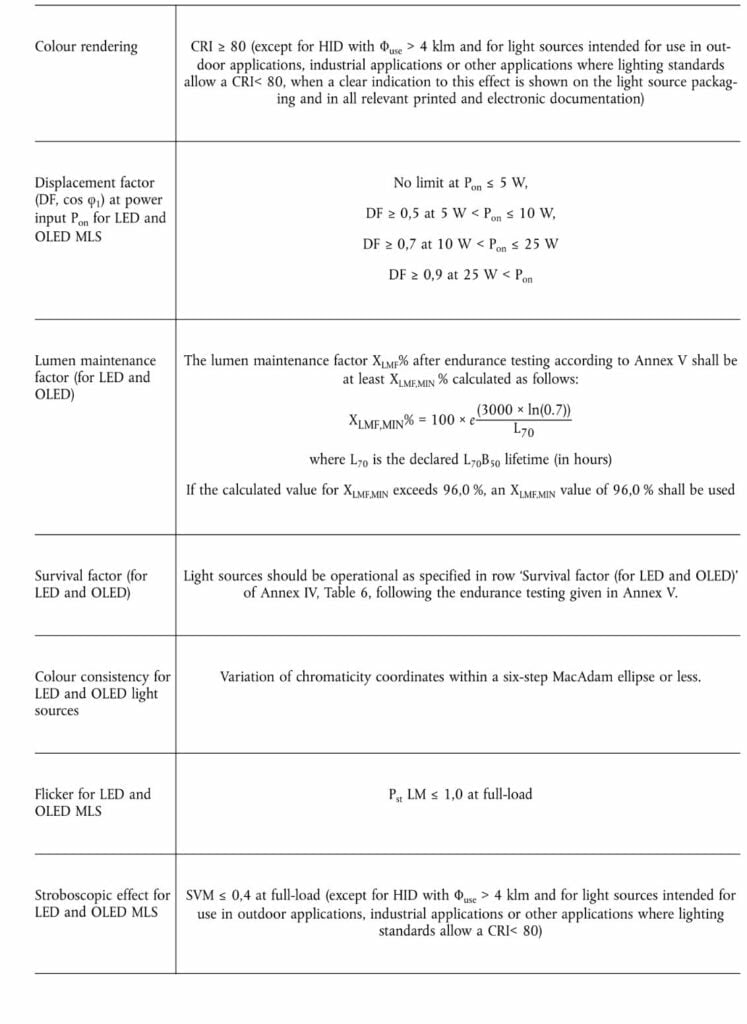
Updated information requirements effective from September 1, 2021, include:
(a) Displaying necessary information directly on the light source.
(b) Displaying required information on the packaging.
(c) Ensuring the visible display of relevant information on a freely accessible website owned by the manufacturer, importer, or authorized representative.
(d) Providing technical documentation as per regulations.
Energy efficiency categories and calculation approach
The formula for calculating energy efficiency label rating
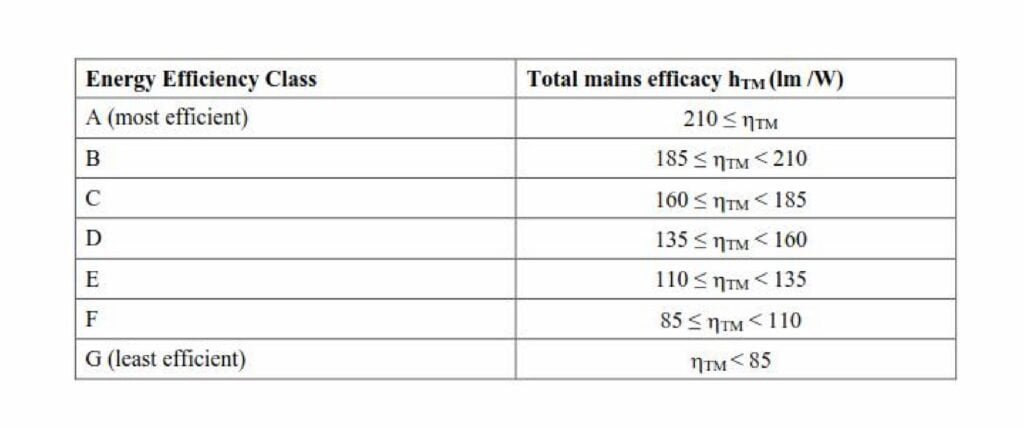

MyLiKeLED specializes in crafting top-tier LED strips and LED neon flex, known for their exceptional quality. Our products undergo rigorous testing in state-of-the-art laboratories to guarantee unparalleled excellence. Additionally, we provide tailored customization options for our LED strips and neon flex. Don’t hesitate to contact MyLiKeLED promptly for access to the premium LED strip and LED neon flex solutions.
Valuable resources for reference purposes
Official Journal of the European Union

Hi, I’m Xylia Xiong, a sales professional with 14 years of experience in the LED strip light industry. I specialize in providing tailored solutions, leveraging my expertise in LED products and the latest industry trends. Known for effective communication and problem-solving, I’m dedicated to helping lighting manufacturers, importers, and distributors achieve their goals.
Let’s work together to create customized solutions that exceed expectations.
Related Posts

The Best LED Strip Lights You Can Buy Right Now

Comparing WS2811 Vs WS2812B: Key Differences


